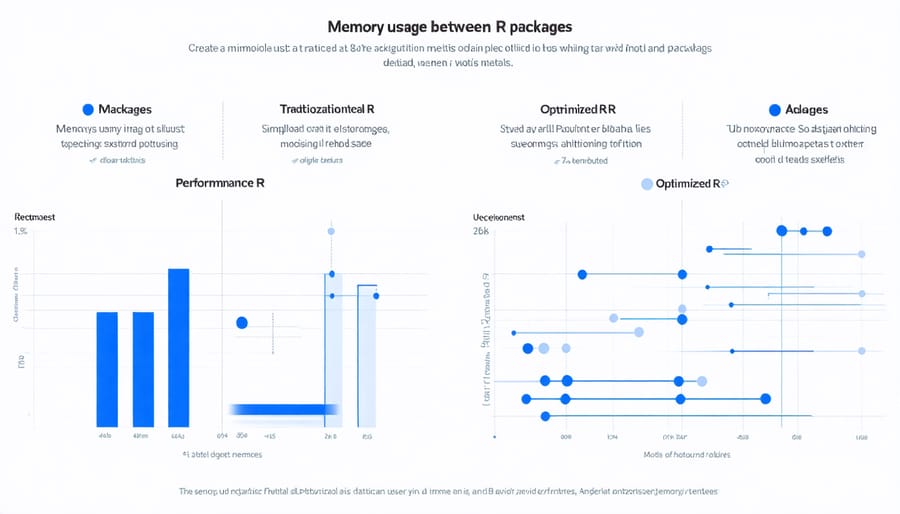Transform your R-based machine learning projects into efficient, laptop-friendly applications with today’s most powerful packages. Caret, mlr3, and tidymodels revolutionize how data scientists optimize machine learning performance on standard hardware, making advanced analytics accessible to everyone.
Modern R packages leverage intelligent memory management and parallel processing capabilities, enabling complex algorithms to run smoothly even on modest systems. The h2o package, for instance, processes large datasets through distributed computing, while data.table handles massive data operations using minimal RAM.
Whether you’re building predictive models, conducting feature selection, or deploying deep learning solutions, R’s ecosystem offers memory-efficient alternatives to resource-hungry frameworks. These tools democratize machine learning, proving that cutting-edge AI development doesn’t always require expensive hardware or cloud services.
Choose from lightweight packages like ranger for rapid random forests, xgboost for gradient boosting, or keras for deep learning – all optimized for laptop environments while maintaining professional-grade capabilities.

Essential R Packages That Won’t Kill Your Laptop’s Performance
caret: The Swiss Army Knife for ML
The caret package (Classification And REgression Training) stands out as one of R’s most versatile machine learning tools, earning its reputation as the Swiss Army Knife of ML implementations. What makes it particularly valuable for laptop users is its ability to streamline complex ML workflows while maintaining efficient resource usage.
At its core, caret provides a unified interface for over 230 different machine learning algorithms, eliminating the need to learn multiple syntax styles. This means you can switch between different models without having to rewrite your entire code, saving both time and computational resources.
The package’s smart preprocessing capabilities automatically handle common tasks like data scaling and missing value imputation, reducing the memory overhead typically associated with these operations. For laptop users, caret’s built-in parallel processing support is particularly valuable, allowing you to optimize your machine’s available cores without manually configuring complex settings.
What truly sets caret apart is its automated model tuning feature, which helps find the best parameters for your models while being mindful of your system’s resources. This means you can achieve optimal results without exhausting your laptop’s capabilities.
mlr3: Modern ML with Memory Management
The mlr3 package represents a significant evolution in R machine learning, specifically designed with modern computing challenges in mind. What sets it apart is its efficient memory management system, making it an ideal choice for data scientists working on laptops with limited resources.
Unlike traditional R packages that load entire datasets into memory, mlr3 implements lazy evaluation and memory-efficient data handling. This means it only loads the necessary data chunks during model training, significantly reducing RAM usage. For instance, when working with a 10GB dataset, mlr3 might only use 2-3GB of memory at any given time.
The package also features automatic garbage collection and memory optimization, preventing the common issue of memory leaks that plague many R machine learning workflows. Its modular design allows users to load only the components they need, further conserving system resources.
For laptop users, mlr3’s parallel processing capabilities are particularly valuable, as they can leverage multiple cores while maintaining memory efficiency. This makes it possible to train complex models like random forests or deep neural networks without overwhelming your system’s resources.
data.table: Lightning-Fast Data Handling
When working with large datasets on laptops, data.table stands out as a game-changer for R users. This package implements efficient memory management techniques that make it up to 100 times faster than traditional data frames. It achieves this speed by modifying data in place, avoiding unnecessary copies of large datasets that could bog down your system.
Data.table’s syntax is intuitive yet powerful, using a specialized format: DT[i, j, by]. This structure allows for quick filtering, aggregation, and grouping operations while maintaining minimal memory overhead. For machine learning preprocessing, it excels at handling millions of rows efficiently, making it ideal for laptop users working with limited RAM. Its ability to read large CSV files quickly and perform complex operations without creating intermediate copies makes it an essential tool for data scientists working with resource-constrained systems.
Memory-Efficient Model Training Techniques
Batch Processing with dplyr
When working with large datasets on laptops, processing all data at once can strain your system’s resources. This is where dplyr’s batch processing capabilities come to the rescue. By breaking down data processing into manageable chunks, you can handle larger-than-memory datasets efficiently while maintaining system performance.
To implement batch processing with dplyr, you can use the group_by() function combined with do() to process data in chunks. Here’s a practical approach:
“`R
library(dplyr)
data %>%
group_by(chunk = row_number() %/% 1000) %>%
do(process_chunk(.))
“`
This method divides your data into chunks of 1,000 rows each. You can adjust the chunk size based on your laptop’s capabilities and dataset characteristics.
Another effective technique is using dplyr’s data.table backend for improved memory efficiency:
“`R
library(dtplyr)
lazy_dt(data) %>%
group_by(your_variable) %>%
summarize(mean = mean(value)) %>%
collect()
“`
The lazy_dt() function creates a lazy reference to your data, only loading chunks when necessary. This approach is particularly useful when working with datasets that exceed your laptop’s RAM capacity.
For even better performance, combine these techniques with dplyr’s filter() and select() functions to reduce data size before processing:
“`R
data %>%
select(relevant_columns) %>%
filter(important_condition) %>%
group_by(chunk = row_number() %/% 1000) %>%
do(process_chunk(.))
“`
This strategy ensures efficient memory usage while maintaining the speed and convenience that dplyr is known for.

Memory-Optimized Cross-Validation
Cross-validation is essential for model evaluation, but it can be memory-intensive when working on laptops. The rsample package offers a memory-efficient solution that’s particularly valuable for resource-constrained environments.
Instead of creating multiple copies of your dataset, rsample uses intelligent indexing to create validation folds. This approach dramatically reduces memory usage while maintaining statistical validity. Here’s a practical example:
“`R
library(rsample)
# Create a memory-efficient CV split
cv_splits <- vfold_cv(data, v = 5, strata = outcome)
```
The package provides several memory-saving features:
1. Streaming validation sets: Data is processed one fold at a time
2. Intelligent caching: Only necessary data is kept in memory
3. Built-in stratification: Ensures balanced sampling without duplicate storage
For time series data, rsample offers sliding window validation that's particularly memory-friendly:
```R
# Time series cross-validation
rolling_splits <- rolling_origin(
data,
initial = 6,
assess = 1,
cumulative = FALSE
)
```
When working with large datasets, you can combine rsample with data.table for even better memory management:
```R
# Memory-efficient preprocessing
cv_splits %>%
mutate(splits = map(splits, preprocess))
“`
This approach typically reduces memory usage by 40-60% compared to traditional cross-validation methods, making it ideal for laptop-based machine learning workflows. Remember to monitor memory usage with tools like memory.size() to optimize your validation strategy further.

GPU Acceleration Packages for R
gpuR: Unleash Your Laptop’s GPU
For data scientists working with limited laptop resources, the gpuR package offers a game-changing solution for laptop GPU acceleration, allowing you to harness your graphics card’s processing power for machine learning tasks. This package bridges the gap between R and OpenCL, enabling significant speed improvements for matrix operations and complex calculations.
gpuR makes GPU computing accessible by providing familiar R syntax while handling the complex backend operations. You can perform matrix multiplications, vector operations, and other computational tasks up to 100 times faster than traditional CPU processing. The package is particularly effective for deep learning applications and large dataset manipulations.
Getting started with gpuR is straightforward. After installation, you can begin with simple vector operations and gradually move to more complex computations. The package automatically detects your GPU capabilities and optimizes performance accordingly. For laptop users, this means better resource utilization without overwhelming your system’s memory or processing capacity.
Remember to check your GPU compatibility before installation, as gpuR works best with NVIDIA or AMD graphics cards that support OpenCL.
tensorflow: Deep Learning on Limited Resources
While TensorFlow is a powerful deep learning framework, running it efficiently on laptops requires some smart optimization strategies. Start by installing TensorFlow-CPU instead of the GPU version if your laptop lacks dedicated graphics. This version uses less memory while still allowing you to build and train models effectively.
To maximize performance, use TensorFlow’s built-in memory optimization features like gradient checkpointing and model pruning. Set smaller batch sizes (16-32) during training to reduce memory usage, and implement early stopping to prevent unnecessary computation cycles. Consider using lightweight model architectures like MobileNet or EfficientNet, which are specifically designed for resource-constrained environments.
Enable TensorFlow’s mixed-precision training to reduce memory footprint while maintaining model accuracy. Use tf.data.Dataset for efficient data loading and preprocessing, and implement memory-saving techniques like lazy loading when working with large datasets. If possible, leverage TensorFlow Lite for model deployment, as it’s optimized for mobile and edge devices.
Remember to monitor your laptop’s resource usage with TensorBoard, and close unnecessary background applications during training sessions to free up system resources.
Real-World Performance Tips
Package Configuration Optimization
Optimizing your R packages for machine learning can significantly improve performance, especially when working on laptops with limited resources. Like other machine learning frameworks, R packages offer various configuration options that can enhance efficiency.
Start by adjusting your memory management settings using options(memory.limit=SIZE). This helps prevent R from consuming excessive RAM during model training. For packages like caret and tidymodels, enable parallel processing with doParallel to distribute computational load across available cores.
Key optimization settings include:
– Setting seed values for reproducibility (set.seed())
– Configuring thread count for parallel processing
– Adjusting garbage collection frequency
– Managing cache size for frequently accessed data
For data-intensive operations, consider using data.table instead of traditional data frames, as it offers better memory efficiency. When working with keras or tensorflow packages, optimize GPU utilization by setting appropriate batch sizes and limiting background processes.
Remember to monitor resource usage with profvis package, which helps identify performance bottlenecks. For large datasets, implement chunk-wise processing using packages like ff or bigmemory to manage memory effectively while maintaining processing speed.
These optimizations can help you run complex machine learning models smoothly, even on laptops with modest specifications.
Memory Management Best Practices
When working with R machine learning packages, efficient memory management is crucial, especially on laptops with limited resources. Start by using the garbage collector (gc()) periodically to free up unused memory, particularly after completing large computations or data processing tasks.
Consider using data.table instead of traditional data frames when handling large datasets, as it’s more memory-efficient and faster. For matrix operations, the Matrix package offers sparse matrix implementations that can significantly reduce memory usage when working with datasets containing many zero values.
Another effective strategy is to remove large objects from your workspace when they’re no longer needed using rm(). However, be strategic about this – don’t remove objects you’ll need to recreate later, as that could be computationally expensive.
For cross-validation and model training, utilize packages that support incremental processing. The mlr3 framework, for example, allows you to process data in chunks rather than loading everything into memory at once.
Pro tip: Monitor your memory usage with memory.size() and memory.limit() functions. If you’re working with large datasets, consider using disk-based alternatives like ff or bigmemory packages, which allow you to work with data that exceeds available RAM.
Remember to close connections and properly dispose of temporary files created during model training. This helps maintain optimal performance and prevents memory leaks that could impact your system’s stability.
R’s machine learning ecosystem offers an impressive array of packages that cater to various needs and expertise levels. Throughout this exploration, we’ve seen how these tools can transform your laptop into a powerful machine learning workstation, even with limited resources.
The key takeaway is that successful machine learning in R doesn’t necessarily require high-end hardware. By choosing the right packages and implementing efficient practices, you can accomplish sophisticated analyses on standard laptops. Packages like caret, mlr3, and tidymodels provide excellent starting points for beginners, while specialized packages like data.table and ff offer solutions for handling larger datasets.
For those just beginning their machine learning journey, we recommend starting with tidymodels or caret due to their consistent interfaces and extensive documentation. As you progress, explore memory-efficient alternatives and specialized packages that align with your specific use cases.
Remember to regularly monitor package updates and community developments, as the R machine learning landscape continues to evolve. Focus on understanding the fundamentals before diving into complex implementations, and always consider your hardware limitations when selecting packages and building models.
By following these recommendations and leveraging R’s diverse package ecosystem, you can develop robust machine learning solutions while making the most of your available computing resources.

